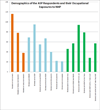Primates and primatologists: social contexts for interspecies pathogen transmission
- PMID: 21932331
- PMCID: PMC3244521
- DOI: 10.1002/ajp.20988
Primates and primatologists: social contexts for interspecies pathogen transmission
Abstract
Humans and nonhuman primates (NHP) interact in a variety of contexts. The frequency, duration, and intensity of interspecies interaction influence the likelihood that contact results in cross-species transmission of infectious agents. In this study, we present results of a cross-sectional survey of attendees at a national conference of primatologists, characterizing their occupational exposures to NHP. Of 116 individuals who participated in the study, 68.1% reported having worked with NHP in a field setting, 68.1% in a laboratory setting, and 24.1% at a zoo or animal sanctuary. Most subjects (N=98, 84.5%) reported having worked with multiple NHP taxa, including 46 (39.7%) who had worked with more than five distinct taxa. Sixty-nine subjects (59.5%) recalled having been scratched by a NHP and 48 (41.1%) had been bitten; 32 subjects reporting being bitten more than once. Eleven subjects (9.5%) reported having been injured by a needle containing NHP tissue or body fluids. We conclude that primatologists are at high risk for exposure to NHP-borne infectious agents. Furthermore, primatologists' varied occupational activities often bring them into contact with multiple NHP species in diverse contexts and geographic areas, over extended periods of time, making them a unique population with respect to zoonotic and anthropozoonotic disease risk.
© 2011 Wiley Periodicals, Inc.
Figures



Similar articles
-
Rethinking Human-Nonhuman Primate Contact and Pathogenic Disease Spillover.Ecohealth. 2017 Dec;14(4):840-850. doi: 10.1007/s10393-017-1283-4. Epub 2017 Nov 17. Ecohealth. 2017. PMID: 29150826 Review.
-
Using physical contact heterogeneity and frequency to characterize dynamics of human exposure to nonhuman primate bodily fluids in central Africa.PLoS Negl Trop Dis. 2018 Dec 27;12(12):e0006976. doi: 10.1371/journal.pntd.0006976. eCollection 2018 Dec. PLoS Negl Trop Dis. 2018. PMID: 30589843 Free PMC article.
-
Contact to Non-human Primates and Risk Factors for Zoonotic Disease Emergence in the Taï Region, Côte d'Ivoire.Ecohealth. 2015 Dec;12(4):580-91. doi: 10.1007/s10393-015-1056-x. Epub 2015 Aug 25. Ecohealth. 2015. PMID: 26302959
-
[Mechanisms of viral emergence and interspecies transmission: the exemple of simian foamy viruses in Central Africa].Bull Acad Natl Med. 2013 Dec;197(9):1655-67; discussion 1667-8. doi: 10.1016/S0001-4079(19)31387-1. Bull Acad Natl Med. 2013. PMID: 26137812 Free PMC article. Review. French.
-
Cross-species pathogen transmission and disease emergence in primates.Ecohealth. 2009 Dec;6(4):496-508. doi: 10.1007/s10393-010-0284-3. Epub 2010 Mar 16. Ecohealth. 2009. PMID: 20232229 Free PMC article.
Cited by
-
Social processes and disease in nonhuman primates: introduction to the special section.Am J Primatol. 2012 Jun;74(6):491-6. doi: 10.1002/ajp.22018. Am J Primatol. 2012. PMID: 22539268 Free PMC article.
-
Zoonotic pathogens in wild Asian primates: a systematic review highlighting research gaps.Front Vet Sci. 2024 Jun 27;11:1386180. doi: 10.3389/fvets.2024.1386180. eCollection 2024. Front Vet Sci. 2024. PMID: 38993279 Free PMC article.
-
Rethinking Human-Nonhuman Primate Contact and Pathogenic Disease Spillover.Ecohealth. 2017 Dec;14(4):840-850. doi: 10.1007/s10393-017-1283-4. Epub 2017 Nov 17. Ecohealth. 2017. PMID: 29150826 Review.
-
Comparative Review of Antimicrobial Resistance in Humans and Nonhuman Primates.Comp Med. 2018 Apr 2;68(2):124-130. Comp Med. 2018. PMID: 29663937 Free PMC article. Review.
-
Viruses in saliva from sanctuary chimpanzees (Pan troglodytes) in Republic of Congo and Uganda.PLoS One. 2023 Jun 29;18(6):e0288007. doi: 10.1371/journal.pone.0288007. eCollection 2023. PLoS One. 2023. PMID: 37384730 Free PMC article.
References
-
- Artenstein AW, Hicks CB, Goodwin BS, Jr., Hilliard JK. Human infection with B virus following a needlestick injury. Review of Infectious Diseases. 1991;13:288–291. - PubMed
-
- B Virus Working Group. Guidelines for prevention of Herpesvirus simiae (B virus) infection in monkey handlers. Journal of Medical Primatology. 1988;17:77–83. - PubMed
-
- Bailes E, Gao F, Bibollet-Ruche F, Courgnaud V, Peeters M, Marx PA, Hahn BH, Sharp PM. Hybrid origin of SIV in chimpanzees. Science. 2003;300:1713. - PubMed
-
- Cascio A, Bosilkovski M, Rodriguez-Morales AJ, Pappas G. The socio-ecology of zoonotic infections. Clinical Microbiology and Infection. 2011;17:336–342. - PubMed
Publication types
MeSH terms
Grants and funding
LinkOut - more resources
Full Text Sources
Medical

